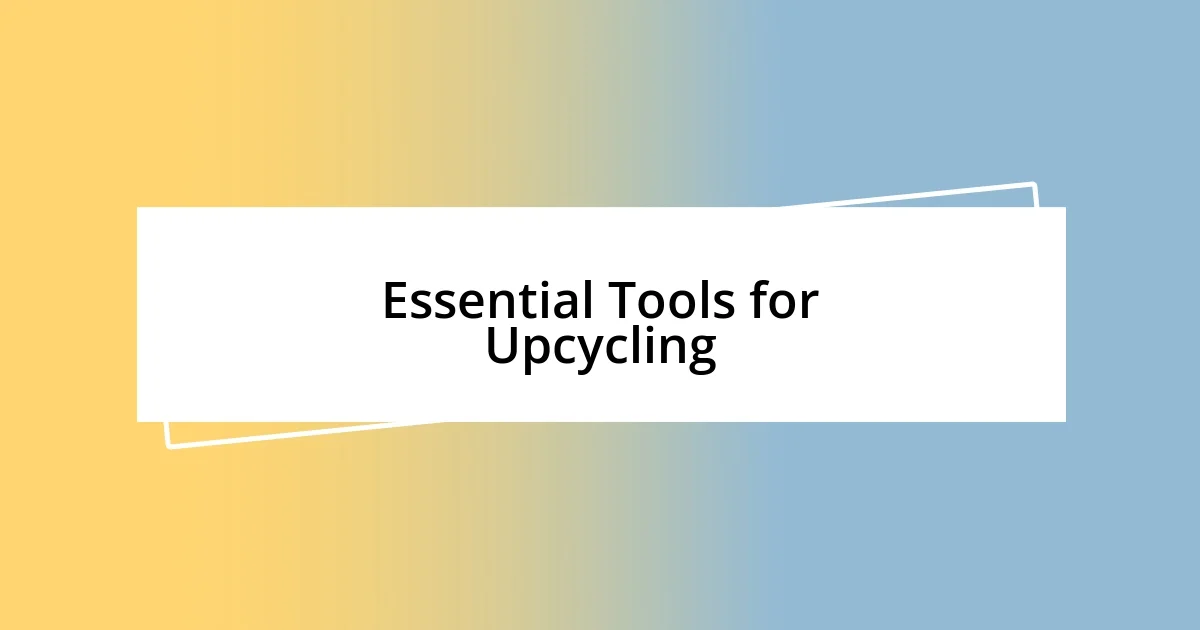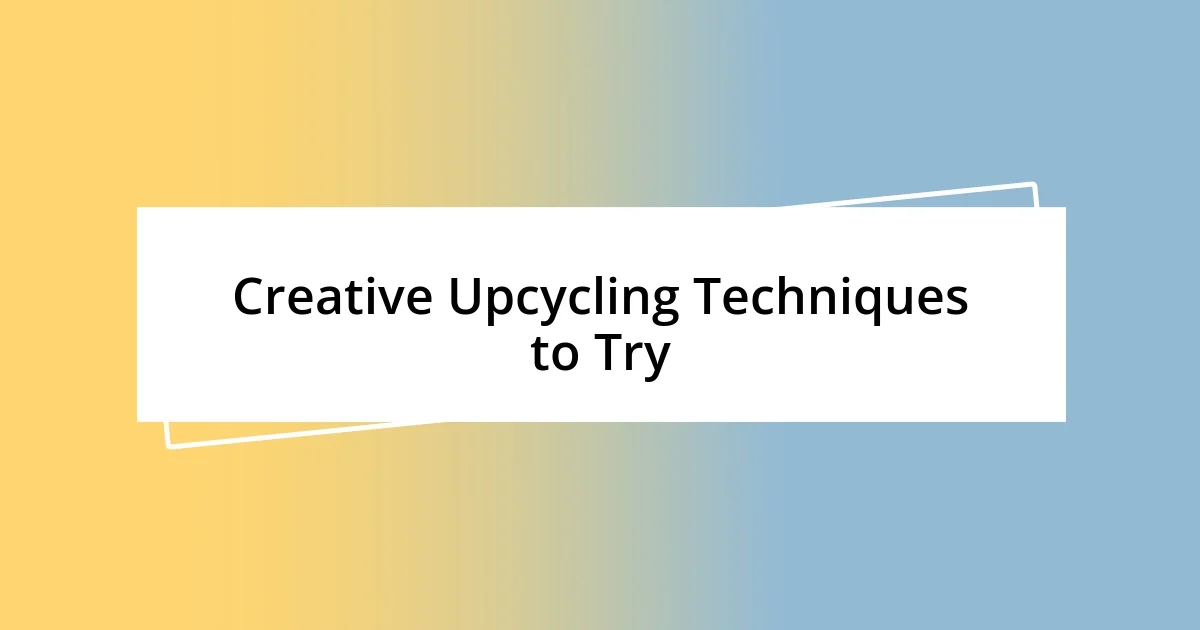Key takeaways:
- Upcycled fashion combines creativity with sustainability, transforming waste into unique, personalized items while fostering a sense of responsibility for the environment.
- Essential tools for upcycling, such as fabric scissors and a sewing machine, enhance the crafting experience and support the creation of high-quality, durable pieces.
- Embracing unexpected materials and experimenting with techniques can lead to innovative projects, allowing for personal expression and contributing to a more sustainable wardrobe.

Introduction to Upcycled Fashion
Upcycled fashion is all about breathing new life into items that might otherwise end up in a landfill. Personally, I feel a thrill whenever I turn a worn-out pair of jeans into a trendy tote bag—there’s something deeply satisfying about creating beauty from something considered waste. Have you ever thought about how much impact small changes like this can make?
When I first stumbled upon upcycled fashion, I was struck by how it combines creativity with sustainability. I remember rummaging through my closet, finding an old dress that didn’t fit anymore, and transforming it into a chic top. It was an eye-opening experience; I realized that the stories behind our clothes can be just as valuable as their style or condition. Isn’t it wonderful how each piece can carry a history, yet still become a part of our present?
The world of upcycled fashion encourages not only ingenuity but also a sense of responsibility for our planet. I once attended a local craft fair where artisans showcased their upcycled creations, and I couldn’t help but feel inspired. How often do we stop to consider the environmental footprint of our style choices? Engaging with upcycled fashion has truly reshaped my perspective, reminding me that every stitch can contribute to a brighter, more sustainable future.

My Journey into Upcycling
When I embarked on my upcycling journey, it felt almost serendipitous. One day, while cleaning out my closet, I discovered a long-forgotten pair of corduroy pants in a vibrant mustard color. Instead of just donating them, I decided to transform them into a cozy throw pillow. The moment I finished sewing, I felt a rush of pride—this simple act not only decluttered my space, but it also allowed me to express my creativity.
As I delved deeper into upcycling, I began to explore different techniques. I recall my first attempt at fabric dyeing—turning a faded white shirt into a rich blue masterpiece. The thrill of experimentation was unmatched; here was a place where mistakes became happy accidents that led to unique pieces. How invigorating it was to realize that my wardrobe could be a canvas waiting to be painted with my personal touch!
This journey has also prompted me to connect with others who share a passion for sustainable fashion. I joined an online community where we swap ideas and share our projects. It struck me how similar our experiences often are, yet each project carries a unique story. Isn’t it comforting to know that through upcycling, we’re not just reviving clothes but also building a supportive network dedicated to making a positive impact?
| Upcycling Experience | Traditional Fashion Practices |
|---|---|
| Creates personalized, one-of-a-kind items | Typically mass-produced and lacks individuality |
| Promotes sustainability by reducing waste | Often contributes to environmental pollution |
| Encourages creativity and innovation | Restricts expression to current fashion trends |
| Fosters community connections and shared experiences | Can isolate consumers in fast fashion cycles |

Essential Tools for Upcycling
When diving into upcycled fashion, having the right tools can make all the difference. I remember my first project, where I struggled to cut fabric without the proper scissors—frustrating, to say the least! Investing in quality tools not only enhances the experience but also elevates the final outcome, allowing your creativity to shine. Here’s a list of essential items I highly recommend:
- Fabric scissors: These are a must for clean cuts; dull scissors can ruin your project.
- Sewing machine: While hand-sewing can be charming, a machine speeds things up and allows for more intricate designs.
- Rotary cutter and cutting mat: Perfect for precise measurements, especially when working with patterns.
- Measuring tape and ruler: Accuracy is key in upcycling; these tools help ensure everything aligns perfectly.
- Pins and clips: They keep your fabric in place, preventing shifts while you sew.
- Needles and threads in various colors: Having a range on hand ensures you can match or contrast as needed.
Selecting the right tools can truly enhance your upcycling adventures. During my first attempt at making a clutch from an old pair of jeans, I underestimated the importance of good quality thread. Halfway through, my thread snapped, and I had to start over! I learned that investing in decent materials not only saves time but also adds durability to your creations. Upcycling is a beautiful blend of practicality and artistry, and having these essential tools will empower anyone ready to dive into this transformative craft.

Creative Upcycling Techniques to Try
Exploring the world of upcycled fashion has been a delightful adventure for me, especially when it comes to innovative techniques. One of my favorites is turning old t-shirts into stylish tote bags. It’s as simple as cutting off the sleeves and knotting the bottom—no sewing required! The first time I did this, I was amazed at how a worn-out shirt could transform into a practical, eco-friendly bag. Have you ever thought about how easy it is to give new life to your clothes?
Something else I love is using fabric scraps to create patchwork designs. I remember taking leftover pieces from various projects and stitching them together to make a vibrant wall hanging. This not only added a pop of color to my space but also sparked conversations with friends who admire upcycling. Plus, it’s incredibly satisfying to see a beautiful design emerge from what would have otherwise been waste. Have you ever considered how patchwork can be a canvas for your personal story?
Another creative technique I adore is the art of embellishment using upcycled materials. Imagine taking an old denim jacket and adding a few colorful patches or even some fabric paint. It’s a chance to truly personalize your clothing. The first time I adorned a jacket with patches I found at flea markets, I felt an overwhelming sense of pride. It was like wearing a piece of art that tells my unique story. How often do we get the chance to express ourselves so vividly through fashion?

Eco-Friendly Benefits of Upcycled Fashion
The eco-friendly benefits of upcycled fashion are truly remarkable. I remember feeling a sense of fulfillment the first time I transformed a neglected piece of clothing into something new. Not only did I save that garment from ending up in a landfill, but I also contributed to reducing the demand for fast fashion production, which is notorious for its environmental impact. Have you thought about the weight of your wardrobe on the planet?
In my journey with upcycled fashion, I’ve seen firsthand how it promotes sustainability. When I created a patchwork skirt from old jeans and fabric remnants, I was amazed by the realization that those materials would have otherwise gone to waste. It’s not just about creating; it’s about making conscious choices that benefit our environment. Each upcycled piece becomes a step towards reducing our carbon footprint. How fulfilling is it to know your style choices reflect your values?
Moreover, embracing upcycled fashion fosters a unique sense of individuality. Every upcycled item I wear carries a story, which resonates deeply with me. For example, the first jacket I enhanced with vibrant patches from my travels feels like it holds memories of adventures. Instead of blending in with mass-produced clothing, upcycled pieces allow us to express our personalities in a way that’s environmentally friendly. Isn’t it wonderful to wear something that is not just a fashion statement, but also a testament to our commitment to the planet?

Tips for Successful Upcycling Projects
When starting an upcycling project, I’ve found that having a clear vision helps immensely. I once stumbled upon a pair of jeans that were too big but too good to toss out. I envisioned a stylish shorts transformation, so I measured, cut, and even added some fun fringe to the hem. With a plan in hand, the process felt more like creativity flowing rather than just cutting fabric haphazardly. Isn’t it amazing how a little foresight can spark innovation in our crafting?
One of my go-to tips is to embrace the unexpected when selecting materials. I remember a time I came across some old bed sheets with a funky pattern; instead of relegating them to the back of a closet, I converted them into a chic summer dress. The soft fabric draped beautifully, and every time I wear that dress, it reminds me of my resourcefulness. Have you ever considered how repurposing unexpected materials can lead to unique creations?
Finally, don’t shy away from experimenting with techniques that might seem out of your comfort zone. The first time I tackled sewing on a button was a disaster—but a necessary one! I made several mistakes, but each error taught me something valuable. Now, I often incorporate intricate stitching into my upcycling projects, and I revel in the satisfaction of mastering new skills. What have you learned about yourself through your own upcycling adventures?














